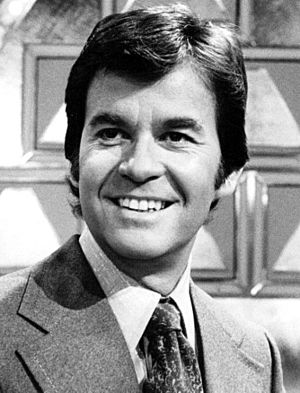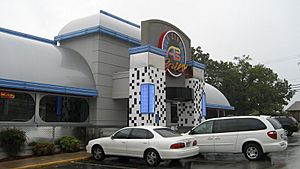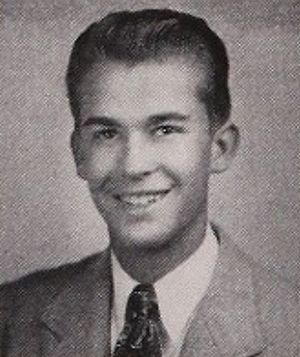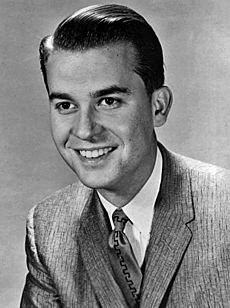Dick Clark facts for kids
Quick facts for kids
Dick Clark
|
|
|---|---|

Clark in 1974
|
|
| Born |
Richard Wagstaff Clark
November 30, 1929 Bronxville, New York, U.S.
|
| Died | April 18, 2012 (aged 82) Santa Monica, California, U.S.
|
| Alma mater | Syracuse University |
| Occupation |
|
| Years active | 1945–2012 |
| Organization | Dick Clark Productions |
| Spouse(s) |
Barbara Mallery
(m. 1952; div. 1961)Loretta Martin
(m. 1962; div. 1971)Kari Wigton
(m. 1972) |
| Children | 3, including Duane |
| Parent(s) | Julia Barnard (1897–1973), Richard A. Clark Sr. (1896–1989) |
| Awards | Full list |
Richard Wagstaff Clark (November 30, 1929 – April 18, 2012) was a famous American television and radio host. He was best known for hosting American Bandstand from 1956 to 1989. He also hosted the Pyramid game show and Dick Clark's New Year's Rockin' Eve. This New Year's Eve show broadcast celebrations from New York City's Times Square.
As the host of American Bandstand, Clark helped introduce rock and roll music to many Americans. The show gave many new music artists their first chance to be seen by a national audience. Some of these artists included Stevie Wonder, Prince, and Madonna. American Bandstand was one of the first TV shows where black and white performers appeared on the same stage. It was also one of the first where the audience sat together without separation by race. Because he always looked young and his audience was mostly teenagers, Clark was often called "America's oldest teenager."
Beyond hosting, Clark was also a successful businessman. He was the chief executive officer of Dick Clark Productions. He also created and produced the yearly American Music Awards show, which is similar to the Grammy Awards.
Contents
Early Life and Radio Beginnings
Dick Clark was born in Bronxville, New York. He grew up in nearby Mount Vernon. He was the second child of Richard Augustus Clark and Julia Fuller Clark. His older brother, Bradley, was a pilot who died in World War II.
Clark went to A.B. Davis High School in Mount Vernon. When he was 10, he decided he wanted to work in radio. To achieve this goal, he went to Syracuse University. He graduated in 1951 with a degree in advertising and a minor in radio.
Clark started his career in 1945 working in the mailroom at WRUN. This was an AM radio station in Utica, New York. His uncle owned the station, and his father managed it. Soon, he was asked to fill in for the weatherman. Within a few months, he was announcing station breaks.
While at Syracuse University, Clark worked at WOLF-AM, a country music station. After graduating, he worked at WRUN again for a short time. He then got a job at the television station WKTV in Utica, New York. His first TV hosting job was on a country music show called Cactus Dick and the Santa Fe Riders.
American Bandstand Takes Off
In 1952, Clark moved to Drexel Hill, Pennsylvania, near Philadelphia. He became a disc jockey at radio station WFIL. WFIL also had a TV station (now WPVI) that aired a show called Bob Horn's Bandstand. Clark hosted a similar radio show and often filled in for Horn on TV. On July 9, 1956, Clark became the TV show's permanent host.
The ABC television network picked up the show. It was renamed American Bandstand and first aired nationally on August 5, 1957. The show became very popular because Clark connected well with the teenage audience. He also presented a "clean-cut" image that parents liked. This helped many parents accept rock and roll music.
In 1958, The Dick Clark Show was added to ABC's Saturday night lineup. By the end of that year, more than 20 million people watched it. Artists who appeared on the show were almost guaranteed to sell more records. In 1959, host Ralph Edwards called Clark "America's youngest starmaker." He estimated the show had an audience of 50 million.
Clark moved American Bandstand from Philadelphia to Los Angeles in 1964. This move was partly because of the popularity of new "surf" groups. These included The Beach Boys and Jan and Dean. The show aired daily until 1963, then weekly on Saturdays until 1988. It was briefly brought back in 1989. By the time it was canceled, American Bandstand was the longest-running variety show in TV history.
In the 1960s, the show started featuring live performers. Many leading rock groups of the 1960s first appeared on national TV here. Some of these artists included Ike and Tina Turner, Smokey Robinson and the Miracles, The Beach Boys, Stevie Wonder, Prince, Simon and Garfunkel, Jerry Lee Lewis, and Buddy Holly.
In a 1990 interview, it was noted that most artists in the Rock and Roll Hall of Fame first appeared on American Bandstand. The show featured over 10,000 live performances. Many artists could not appear on other TV shows because they were "anti-rock."
In 2002, many groups he introduced appeared at the 50th anniversary special for American Bandstand. Clark noted that the show was in the Guinness World Records as the "longest-running variety show in TV history."
Clark also helped end the show's all-white policy. He began featuring black artists like Chuck Berry. Over time, black and white performers appeared on the same stage. The studio audience seating also became desegregated. Clark's impact on popular culture was huge. Singer Paul Anka said, "This was a time when there was no youth culture — he created it."
Game Show Hosting Career
In late 1963, Clark started hosting game shows. His first was The Object Is. He later hosted Missing Links.
Clark became the first host of The $10,000 Pyramid. It first aired on CBS on March 26, 1973. The show was a word-association game. It moved to ABC in 1974. Over the years, the top prize changed, and so did the show's name. Several prime-time versions were also created.
Clark continued to host the daytime version of Pyramid for most of its history. He won three Emmy Awards for best game show host. In total, Pyramid won nine Emmy Awards for best game show during his time as host. Clark's last Pyramid hosting job, The $100,000 Pyramid, ended in 1988.
Entertainment Weekly said Clark's "quietly commanding presence" was a big reason for the game show's success.
Clark also hosted other game shows. These included The Challengers (1990–91) and Scattergories (1993). He also hosted It Takes Two in 1997. In 1999, he was an executive producer for Fox's TV game show Greed. At the same time, Clark also hosted Winning Lines on CBS.
Dick Clark's New Year's Rockin' Eve
In 1972, Dick Clark first produced New Year's Rockin' Eve. This was a New Year's Eve music special for NBC. It included coverage of the ball drop in New York City. Clark wanted to compete with Guy Lombardo's New Year's specials. He felt Lombardo's big band music was for an older audience.
After two years on NBC, the show moved to ABC. Clark then became the host. After Lombardo died in 1977, Rockin' Eve became very popular. It later became the most-watched New Year's Eve broadcast each year.
After he had a stroke in 2004, Clark could not host the 2004–05 show. Regis Philbin filled in for him. Clark returned the next year, but his speech was affected by the stroke. He made brief appearances on the show, with Ryan Seacrest taking over most of the hosting duties. Seacrest remained the host after Clark's death.
Radio Programs and Other Ventures
Clark loved radio. In 1963, he started hosting The Dick Clark Radio Show. In 1972, he filled in for Casey Kasem on American Top 40. In 1981, he created The Dick Clark National Music Survey.
In 1982, Clark started his own radio company called the United Stations Radio Network. This company later merged with another. In 1995, Clark started a new version of his radio network. He hosted a new countdown show called The U.S. Music Survey until his stroke in 2004.
Dick Clark's longest-running radio show was Dick Clark's Rock, Roll & Remember. It started on February 14, 1982. This was a four-hour oldies show named after his 1976 autobiography. Each week, Clark would feature a different artist from the rock and roll era. He would also count down the top four songs from a certain year in the 1950s, 1960s, or early 1970s. The show stopped production when Clark had his stroke in 2004.
Clark also hosted other TV shows. These included The Dick Clark Show (1958–1960), which featured rock and roll stars. He also hosted TV's Bloopers & Practical Jokes with Ed McMahon. This show featured funny mistakes from TV and movies. For a few years in the 1980s, Clark hosted regular shows on all three major American TV networks at the same time.
From 2001 to 2003, Clark was a co-host of The Other Half. This was a syndicated daytime talk show for men. Clark also produced the TV series American Dreams (2002–2005). This show was about a Philadelphia family in the early 1960s. Their daughter was a regular on American Bandstand.
Business Ventures and Restaurants

In 1965, Clark started producing TV shows. He produced Where The Action Is, an afternoon show. In 1973, Clark began producing the very successful American Music Awards. In 1987, Dick Clark Productions became a public company. Clark continued to be active in TV and movie production into the 1990s.
Clark also had a share in a chain of music-themed restaurants. These were named "Dick Clark's American Bandstand Grill" and similar names. There are still some airport locations and one at "Dick Clark's American Bandstand Theater" in Branson, Missouri.
"Dick Clark's American Bandstand Theater" opened in Branson in April 2006. A new theater and restaurant called "Dick Clark's American Bandstand Music Complex" opened near Dolly Parton's Dollywood theme park in Pigeon Forge, Tennessee.
Personal Life and Health
Clark was married three times. His first marriage was to Barbara Mallery in 1952. They had one son, Richard A. Clark, and divorced in 1961. He married Loretta Martin in 1962. They had two children, Duane and Cindy, and divorced in 1971. His third marriage was to Kari Wigton in 1977, and they were married until his death. He also had three grandchildren.
In April 2004, Clark shared that he had type 2 diabetes. In December 2004, Clark had a stroke. This affected his ability to speak clearly for the rest of his life. He was unable to host his annual New Year's Rockin' Eve broadcast that year.
On April 18, 2012, Dick Clark died from a heart attack in Santa Monica, California. He was 82 years old. His ashes were scattered over the Pacific Ocean.
Legacy and Impact
After Clark's death, many people spoke about his impact. President Barack Obama praised Clark's career. He said, "With American Bandstand, he introduced decades' worth of viewers to the music of our times." Motown founder Berry Gordy said, "Dick was always there for me and Motown... He was an entrepreneur, a visionary and a major force in changing pop culture and ultimately influencing integration." Singer Diana Ross added that Clark presented Motown and the Supremes on tour and on American Bandstand, where she got her start.
Awards and Honors
Television Awards
- Five Emmy Awards
- Four for Best Game Show Host (1979, 1983, 1985, and 1986)
- Daytime Emmy Lifetime Achievement Award (1994)
- Peabody Award (1999)
Halls of Fame
- Hollywood Walk of Fame (1976)
- National Radio Hall of Fame (1990)
- Broadcasting Magazine Hall of Fame (1992)
- Broadcast Pioneers of Philadelphia Hall of Fame (1992)
- Television Hall of Fame (1992)
- Rock and Roll Hall of Fame (1993)
- Disney Legends (2013)
Other Honors
- Broadcast Pioneers of Philadelphia Person of the Year (1980)
Images for kids
See also
 In Spanish: Dick Clark para niños
In Spanish: Dick Clark para niños




